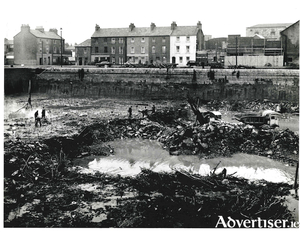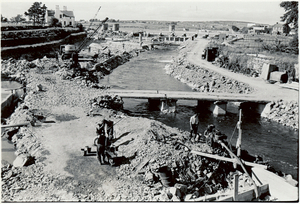Search Results for 'Dredging'
3 results found.
Dredging the Docks, 1963

Since Galway Docks were first constructed, they have undergone many changes. In the decade before the last world war, when transalantic liners were regular callers at the port, and when a fairly thriving coastal trade was being carried out, plans were prepared for the port so that Galway might cater more efficiently for sea traffic. There was a major scheme to build the Dún Aengus dock, the new pier, and to deepen the channel from 1937 to 1939. This meant the removal of thousands of tons of mud, soft materials, and granite. Most of this material was dumped near Hare Island. The work took longer than it should, mostly because of industrial disputes, but it was finally completed in 1939. Two units of the contractor’s equipment, a rock breaker and a floating crane, lay in the Commercial Dock throughout the war years.
The dredging of the river

The main channel discharging all the water from loughs Corrib and Mask is the Galway River, flowing from Lough Corrib through the city to the sea. Among the structures built in 1850 and the following years, during the course of a drainage scheme carried out by what was then known as The Board of Public Works in Ireland, was the main regulating weir across the Corrib at Waterside. Its function was to control the river level at Galway in the interests of draining, milling, and navigation. It was built at a point in the river where the water descended though rapids.
The Corrib Drainage Scheme

The waterways of the city are of great engineering significance. Two major projects resulted in the waterways system which exists today. The first scheme was constructed between 1848 and 1858. Its primary purpose was to improve drainage thus reducing winter water levels and the areas of flooded land and also navigation, without any detrimental effect on the mills or fishery interests. So the Eglinton canal was built, the Claddagh Basin, the dredging of the Corrib, Gaol and Western rivers, tailraces, culverts, the weir and salmon pass and Steamer’s Quay at Woodquay

